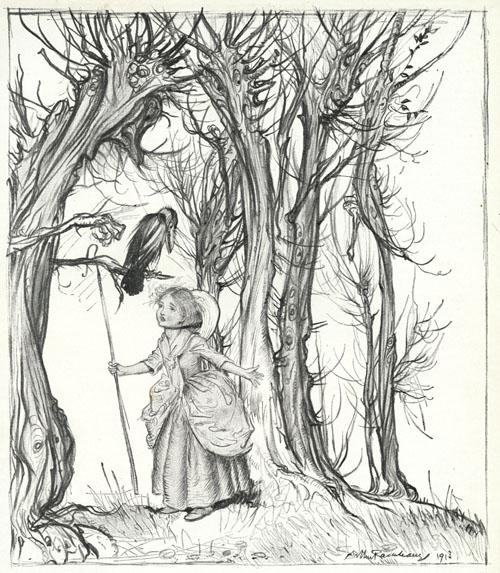
Little Bo Peep from Mother Goose the
Old
Nursery Rhymes, William Heinemann,
1913, 5 ¾ in. x 5 ¼ in., 39h15251,
Baldwin Library of Historical
Children’s Literature
Born in 1867 as one of 12 children, Rackham, unlike many of the artists and illustrators in this exhibition did not spend hours drawing as a child. In 1885, at the age of 18, Rackham began his career at the Westminster Fire Office as an office clerk. Noticing that something was missing from his dull, but secure work as a civil servant, he began studying during the evenings at the Lambeth School of Art. Less than 10 years later, Rackham had illustrated his first book. It was only after he realized he could make a living from his illustrations that Rackham left the safe world of civil service behind, but, unlike many of the illustrators on display, he was not an immediate success.
During the 1890s, Rackham illustrated a total of nine books - steady work to be sure, but it was not until 1900, when he was commissioned to illustrate Fairy Tales by the Brothers Grimm, that he came to the attention of William Heinemann, George Harrap, and Hodder and Stoughton, publishers of deluxe edition gift books. By 1905, when Rackham illustrated Washington Irving’s Rip Van Winkle, he had become England’s leading book illustrator. Although Rackham had succeeded in creating a totally unique style of illustration with the publication of Rip Van Winkle, his work was not without its influences.

[Leaving the Ballroom] from C. S. Evans’Cinderella, William Heinemann,
1919, 8 ½ in. x 6 ½ in., 39h15318, Baldwin Library of Historical Children’s Literature
In 1823, the first edition in English of Children and Household Stories by the Brothers Grimm appeared for sale, with illustrations by George Cruikshank, then England’s leading illustrator in black and white. At first glance, one may not notice any similarity between the work of Rackham and Cruikshank, but if one leans in close and studies the illustrations created by Cruikshank, the darker side of fantasy, which Rackham would masterfully portray over 80 years later, may be glimpsed. Walter Crane, who began his career 30 years before Rackham, illustrating nursery rhymes with bold colors and decorative borders, also illustrated a version of Children and Household Stories in black and white. But for Crane, the power of illustration was to educate and inform children in an entertaining manner. Later in his life, Crane would become a detractor of Rackham’s work, which he referred to as ‘ghouls and monsters’ because he believed they disrupted a child’s development. This was a major difference for the time periods in which these two inventive illustrators lived: the prim world of Victorian England versus the romantic golden age of the Edwardian era with only hints of the tragedy the First World War would bring.


